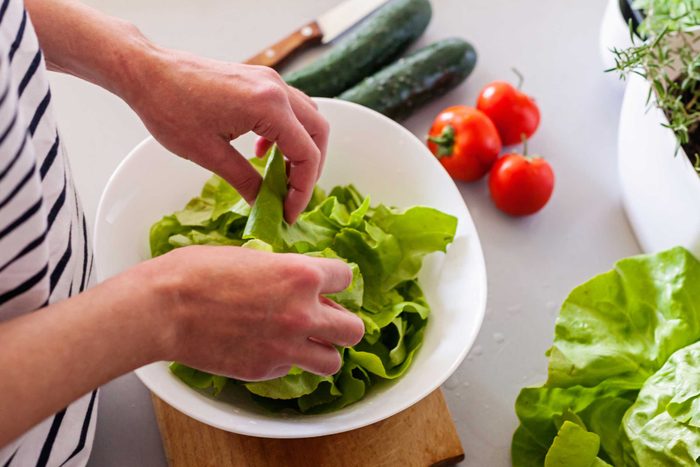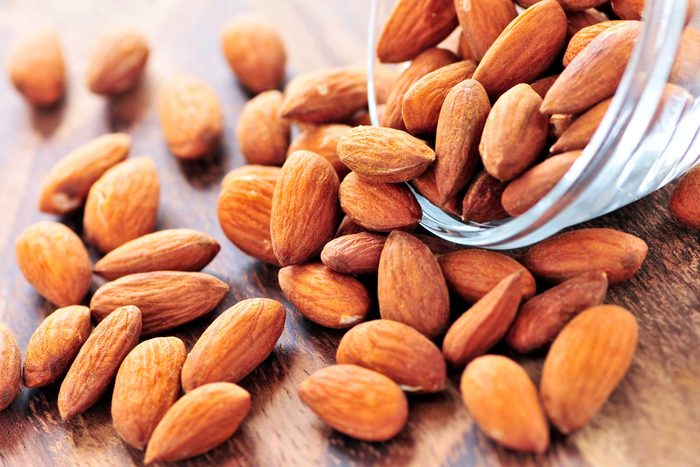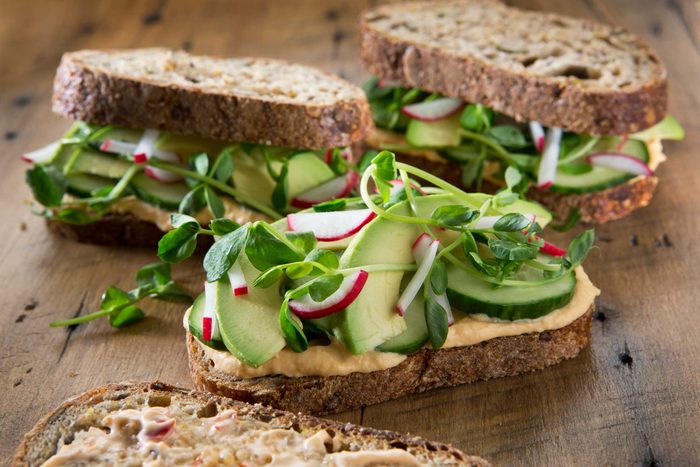
Keep it simple
“People think of changing their eating habits as being all or nothing, a huge makeover; but that just becomes overwhelming,” says Libby Mills, MS, RDN, LDN, spokesperson for the Academy of Nutrition and Dietetics. Instead, make one little change a day (go easy on yourself: skip dessert or eat an extra helping of veggies). It’ll be more manageable and still make a big impact in the long run. Here are eight ways to eat more veggies without even trying.

Start your day with a glass of water
Try starting your day with a glass of water before you inhale a caffeine jolt of coffee. “That dose of liquid is going to jump-start your metabolism and get things moving. It can give you a sense of revival by clearing your head and help get your bowels moving regularly,” says Mills. Place a glass of water on your nightstand before you fall asleep at night; the next morning, drain it before hopping out of bed. Find out 14 easy ways to jump-start your metabolism.

Practice mindful snacking
There’s nothing wrong with snacking as long as you’re making nutritious choices that don’t add hundreds of extra calories to your day. Instead of chips or a candy bar when your lunch starts to wear off, grab a handful of nuts. The fiber and protein will fill you up, and forget what you’ve heard about their fat content. “It’s a valuable type of fat from a healthy, plant-based source, so it’s great for controlling our blood cholesterol,” says Mills. Apples are another good choice because they contain pectin, a type of fiber that plumps up when it comes in contact with the moisture in your stomach, making you feel full.

Get enough calories
Too many calories can become unhealthy, but too little calories can be harmful as well. When you deprive yourself of food, your metabolism slows, causing your body to eat away at muscle and hold on to fat, which can lead to weight gain. “Don’t become obsessed and fixated on numbers, but occasionally tracking how many calories you’re getting is a good way to spot check and make sure you’re making health eating choices,” says Mills. These 12 sneaky habits slow down your metabolism.

Get enough sleep
Changing your eating habits can be as simple as getting enough shuteye. When you’re tired, you’re more likely to overeat or make poor food choices. Lack of sleep can also mess with the levels of hormones that control hunger and metabolism. Get between seven and eight hours of sleep a night.

Eat off smaller plates
Feel free to eat a heaping plate of food, but only if that plate is smaller than regular dinnerware. Cornell researchers found that people who ate cereal out of large bowls consumed 16 percent more cereal than those who were given smaller bowls; however, when asked to estimate how much cereal they thought they’d eaten, large bowl eaters’ estimates were 7 percent lower than those with small bowls. Translation: Eating off smaller dishes helps you eat less but makes you feel like you’re eating just enough. Make sure you don’t believe these common food myths.

Don’t forget breakfast
Even if you’re not a morning eater, try your hardest to eat a little something for breakfast; it can go a long way in keeping your healthy eating habits on track. “My clients who eat breakfast tend to have better control throughout the rest of the day than those who don’t,” says Mills. Eat something that contains protein and fiber and is low in sugar. A veggie omelet, whole grain toast with peanut butter, low fat yogurt with fortified cereal, or these high-protein breakfast ideas are all smart choices that will keep you full until lunch.

Make healthy food swaps
Swapping out caloric spreads and toppings for lighter, healthier options doesn’t mean you need to sacrifice flavor. Instead of butter on your toast or mayo on your sandwich, try spreading hummus on your bread; it’s lower in fat, higher in protein, and packed with flavor. Instead of topping your yogurt with granola, which is often high in sugar, fat, and even salt, spoon a dollop of peanut butter on top and add sliced banana or apple; you’ll get natural sweetness with an extra boost of protein and vitamins. “Low-fat Greek yogurt with fresh grapes and peanut butter or chopped peanuts tastes just like a peanut butter sandwich,” says Mills. These are signs you’re eating too much bad fat.

Bring your lunch
A bagged lunch from home is an easy way to monitor what you’re eating, plus save you a few bucks. Set a reminder on your phone to go off after dinner, then take a few minutes to make a salad or your own bowl (brown rice or quinoa topped with veggies and a protein). Or make a week’s worth of lunches on Sunday with this creative trick. “Use segmented plastic-ware to make a spread of whole grain crackers or whole wheat pita, veggie sticks, fruit, and hummus or a few pieces of cheese. You’ve got a variety of flavors, textures, and shapes that keep it interesting,” says Mills.

Plan ahead
If you do have to buy lunch, plan ahead. “Before you head out, take five minutes and think about lunch and the restaurant you’re going to,” says Mills. By deciding what you’ll order ahead of time, you can stick to a healthier choice and will be less likely to spontaneously order something that fulfills a not-so-healthy craving. Here are 30 healthy-eating tips that could change your life.

Don’t deprive yourself of treats
“A little treat like chocolate is good for the body because if they’re habitual and you cut them out, your body goes into stress mode from deprivation and stimulates cortisol production, which then elevates blood glucose levels; the excess gets stored as fat around out middles,” says Mills. Eat a small square of at least 70 percent dark chocolate, which can have a positive impact on cholesterol levels, blood pressure, and circulation, she says. You can also sprinkle unsweetened cocoa powder on your yogurt or oatmeal for a chocolate-y flavor filled with flavanols, which have antioxidant and ant-inflammatory properties.

Build a decorative fruit bowl
Encourage yourself to eat healthy at home by filling a large bowl with fruit and displaying it on your kitchen counter or table. It doubles as a decoration and healthy snack. Feeling lethargic? These healthy-eating habits will boost your energy.

Think about your unhealthy habits
Acknowledging your unhealthy eating habits can help you figure out how to make healthier ones because you’ll know what to avoid. Make a list of what you do that’s not always healthy—eating when you’re not hungry, skipping meals, eating out every day, etc. Keep them in mind and make a conscious decision to avoid those pitfalls next time mealtime rolls around.

Be a mindful grocery shopper
Really think about what you’re throwing in your cart. If you know you have a tendency to polish off half a bag of chips while watching TV at night, avoid temptation and don’t buy them at all. Make sure you have enough fruits, veggies, whole grains, and healthy protein options to span three meals a day. Don’t miss these healthy-eating secrets from nutritionists.

Drink water throughout the day
“Drinking water all day is going to help you eat smaller portions when you do sit down for a meal because you’re properly hydrated,” says Mills. Dehydration can trick your body into thinking it’s hungry, so your constant snacking could actually mean you’re just thirsty. Next, find out more about the best healthy-eating tips of all time.